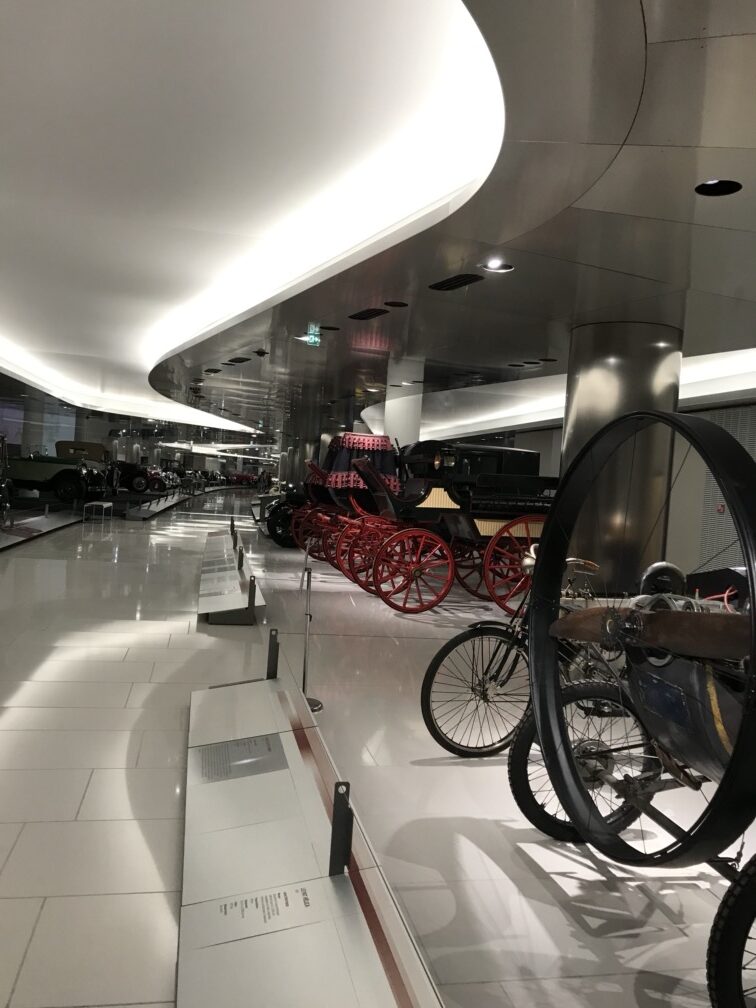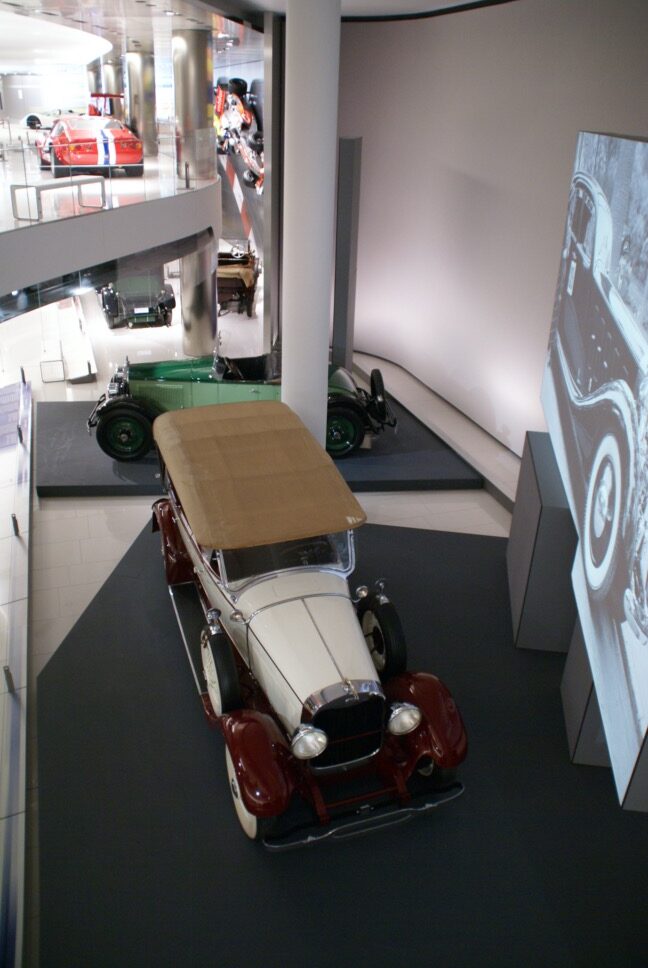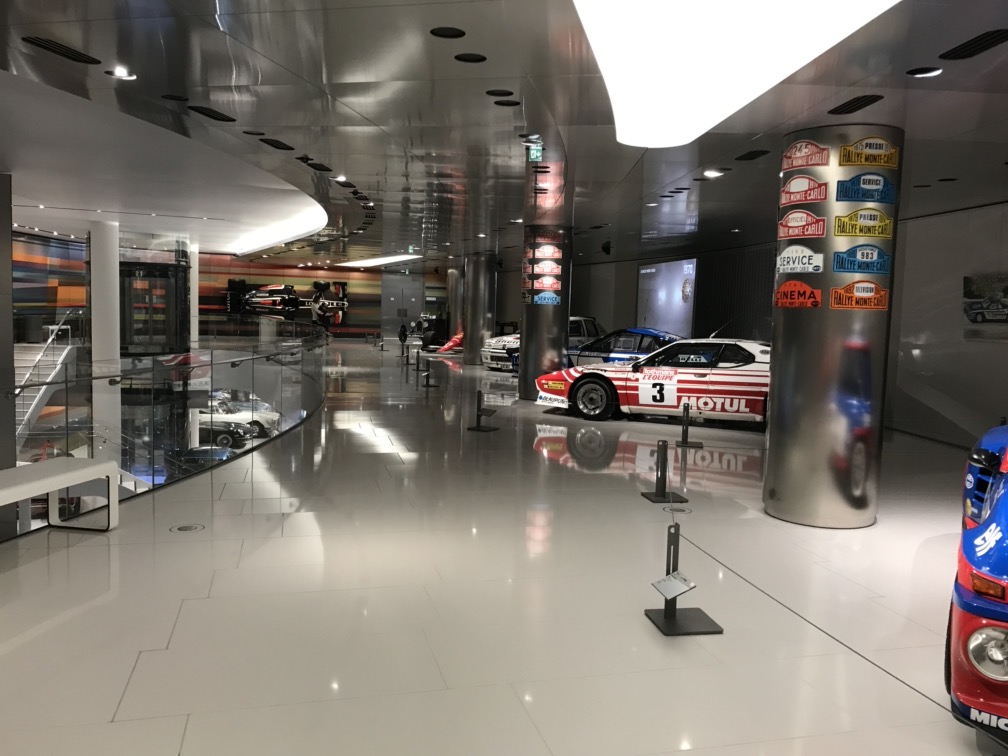

History of the Collection
Monaco is a mecca for motorsport and the automobile in general, and the Princes of Monaco are passionate about beautiful mechanics. Prince Rainier III began buying a few vintage cars in the late 1950s. The first was a 1903 Phaeton De Dion Bouton, reportedly purchased from a student. He has thus gradually assembled a collection of favorites from different eras or cars related to the history of the family or the Principality. Prince Albert II, as passionate as his father, continued the collection in the same spirit, also adding an important component related to motor racing and Monegasque events. As the private collection was cramped in the Palais garage, a museum was opened in 1993 in Fontvieille in a first place of presentation to the public. Prince Albert II had long wanted to offer them a new setting worthy of the collection, but also closer to the nerve center of the Principality’s automotive passion. It is therefore mid-2022 that the new museum opened its doors, on Port Hercule, close to the Grand Prix circuit: the entrance is just before the Louis Chiron bend (the 1st S of the pool), and the museum is under the esplanade used for the stands and grandstands of the Grand Prix. Crossing this esplanade, you are on the other part of the circuit with the offices of the Automobile Club de Monaco and the climb to Ste Dévote that follows the start grid.
Mes coups de coeur
The Collection of H.S.H. The Prince of Monaco brings together above all rare, prestigious cars, in very good condition in a sober and elegant setting. Some favorites to distinguish, always very subjective:
- The Sunbeam Alpine of 1954, a rare and very beautiful car, linked to the history of the Principality of the family
- The selection of GTs of the 1950s and 1960s, the finest sports cars of the time
- The F1 grid
The Princely Collection
The museum is spread over 2 floors and 5000 m², in a bright, sober and elegant setting. On the lower floor, it is mainly passenger cars, while the upper floor is mainly devoted to racing cars. The decoration consists of films illustrating the cars on display, posters (including of the Monaco Grand Prix) and photos related to the automobile and the Principality of Monaco. In addition to a descriptive sheet for each car, panels on the history of the collection, several interactive terminals allow you to search for more detailed information on the cars on display: characteristics, anecdotes, photos, plans... Despite very good lighting, we are not too bothered by parasitic reflections on the bodies. Upon entering the museum, there are windows on the left with posters of the Grand Prix, and many driver helmets, including Ayrton Senna and Nico Rosberg. A model of the front hood of Ferrari allows the visitor to give the illusion, the time of a photo, to drive a rare model of the famous Italian. Just sit on the bench, put your hands on the wheel, and let your imagination run wild. It feels like it, or almost. The visit begins on the lower floor, and the visitor is accompanied in his descent by 2 F1 cars fixed to the wall (a Renault and a Mercedes), and which seem to plunge on an imaginary track flush with the vibrators...








Ancestors and origin
The basement is therefore devoted to old passenger cars, browsing a good part of the 20th century automobile history. We start the visit logically, with the origin and ancestors. When Prince Rainier began his collection in the late 1950s, like many car enthusiasts, he became interested in cars from the very beginning of the twentieth century, witnesses of the great automotive adventure. The technical challenges and the aesthetic choices were still wide open, the solutions may seem rudimentary, but the wood, copper and leather decorations make them fascinating cars. We find in this section a small panorama of the styles of cars that could be found at the beginning of the 20th century.
There is obviously the Dion Bouton Phaeton from 1903, origin of the collection and which is still part of it. It was even used by the princely family to participate in the London-Brighton 1968, famous rally reserved for cars before 1905. A 1921 Hélica recalls the idea of using a propeller to propel the car. 2 very light cars, a cycle car, a kind of combination between car and motorcycle, with its 2 seats in tandem and its belt transmission. The tank is positioned between the driver and the passenger, easy for filling, less obvious to pass a crash test! At his side, a Peugeot Type 161 Quadrilette from 1921, closer to a “classic” car but weighing less than 350kg.




On the back wall, several drawings and plans present the work of the Collection’s restoration workshop. Larger, a Unic Torpédo of 1916, 4 seats, 4-speed gearbox and a weight of 750kg represents the average range with its 4-cylinder 2L. A notch above, the Humber Beeston is equipped with a 6.3L 4-cylinder engine. Copper handles, paint nets on the body, leather seats, it gives itself sporty looks. And we feel that we have gone upmarket. Note, funny detail, that all these cars of very different styles, announce a similar top speed of 70km/h. Probably sufficient given the state of the roads at the beginning of the 20th century.




The Napier T78 of 1914 is a representative of the prestigious English. Here in a “coupé-chauffeur” body where passengers are sheltered, only the driver is exposed to the weather. This series of pioneers is completed by a Renault triplet. In 1911, the Renault AX and the CB Torpédo of 40 HP represent the 2 extremes of a range of 11 models! 2 seats, no door, wooden spoked wheels, an 8hp engine and a measured weight of 800kg, the AX is placed in the cart category, while the CB Torpédo (2.4L, 1500kg) will be both the car of heads of state and crowned heads as well as a sport car setting speed records in the 1920s. We will notice on these 2 cars the huge vertical windshields, held on the wings by straps! Next to it, the Renault KJ1 “coach” of 1922 makes it possible to measure the progress made in a decade: closed and lower body, solid wheels, wider tires, headlights instead of cab lanterns…





There is also a motorcycle in this automobile museum, a Humber of 1903, owned by Prince Albert 1st with which he embarked on great journeys, explored and crossed the France, from Monaco to Paris, but also in Normandy and even England and Switzerland. A pioneer of 2-wheeled tourism, he had the mechanical passion inherited by Rainier III and Albert II. This motorcycle has been carefully restored by the mechanical workshop of the museum. Finally, in this part of the ancestors, are exposed 3 horse-drawn carriages of the Princes of Monaco and dating from the 19th century.
Prestige and elegance
Continuing the visit, we go up very clearly in range with a dozen prestigious cars ranging from the 1920s to 1940s, in perfect harmony with the princely image of the Principality. These are the cars of stars, great fortunes and aristocrats, stars of the concours d’elegance in vogue in the Roaring Twenties. 4 models represent Rolls-Royce, probably the manufacturer with the greatest aura of prestige, in these years and still today. At that time, the manufacturer provided the chassis/engine assembly, which was then completed by a master coachbuilder.
Thus the 4 cars present 4 different styles: a classic limousine with the Rolls-Royce 40/50 HP Silver Ghost by Barker of 1921, a Coupe Phantom I with an imposing but sporty look by Martin & King of 1927, another Phantom I but bodied as a Coupé-Chauffeur by Brewster (1927 also). Despite their 2.4T on the scale, these 2 cars claim a top speed of 125km/h! Finally the Twenty is dressed in Torpédo (still 1927) less powerful and lighter. Whatever the model, there is obviously the traditional Rolls-Royce grille in the shape of a Greek temple, and the famous Spirit of Ecstasy on the radiator cap.





Next to these 4 Rolls, prestigious elegant European and American cars, which also held the top of the pavement. Direct competitor of the English, in the years 1920/1930, the Hispano-Suiza H6 B of 1928 is bodied in “Landaulet” by Kellner. It shows the Guynemer stork on her radiator cap. A large Delage D8-15 Sedan (8-cylinder in-line 2.7L) and a superb Delahaye 135 MS from 1947, in a 4-seater convertible represent the flower of the sporty and luxurious French automobile. With its 125hp for only 1400kg, the Delahaye flirted with 160km / h.
Less known than the XK roadsters that made Jaguar’s reputation after the war, the Jaguar XL 1 is a revival of the pre-war Standard Swallow (which became Jaguar because their SS name was problematic after the 2nd World War). Its small 4-cylinder 1500cc does not make it a sporty, but the car is elegant.




Finally 2 cars represent the very high-end American of the 1920s and 1930s: a Packard Six roadster with spider, small rear seat located outside the cockpit, whose backrest opens like a trunk, and a more imposing Lincoln Type L Torpédo of 1928 which smells good prohibition time. Two-tone, whitewall tires, spoked wheels, mirror mounted on the spare wheel, we picture it in a gangster movie!



In the background of the presentation of these elegant cars, the films illustrate these famous concours d’elegance where the passengers also had to show elegance. Window cases display unusual objects, with soliflores and perfume boxes that adorned the interiors of these cars, adding a touch of elegance and exclusivity.


Family cars
We change (a little) category, but in any case period with some “family” cars. First of all, there are 2 imposing American limousines, used by the principality as ceremonial cars. The 1956 Chrysler Imperial, two-tone body highlighted in chrome, slightly tinted windows, aggressive grille imposes.
Note its curious small taillights surmounting the wings, and the official badge on the roof. In the background, a film shows images of official ceremonies in which she participated. It was this Chrysler Imperial that welcomed Grace Kelly when she arrived in the principality in April 1956. More classic (and classier?), the 1956 Rolls-Royce Silver Cloud Sedan was also used at some princely events.
The 1961 Cadillac Series 6700 Fleetwood Limousine is just as imposing, but in a slightly smoother style. Panoramic windshield, body line low enough to leave a large glass surface, it sports the large fins typical of American 1960s. Much more recent, the Lexus limousine of the princely wedding between Albert II and Charlene (July 2011) has 2 particularities: a “Landaulet” body (only the rear part of the car is discoverable), and a hybrid engine making it an ecological limousine. The car is presented uncovered, but a transparent plexiglass roof protects it from dust and possible incivilities.



The Renault Floride and the Sunbeam Alpine are much less imposing, and are linked to the Princess Grace. The Sunbeam Alpine (1954) is a rare car, especially in left-hand drive. It is the exact replica of the model driven by Grace Kelly, future Princess of Monaco, in Alfred Hitchcock’s film “To catch a thief”. She drives the car on the Moyenne Corniche overlooking the city of Monaco, in the company of Cary Grant. Prince Albert bought this car in 2012 and had it restored by the museum’s technical team, identical to the model of the film that had disappeared.



As for the Florida, it was offered by the manufacturer in 1959 when it was released. Renault wanted to take advantage of the prestige and glamour of Princess Grace to promote this small coupe derived from the Dauphine (another will be offered to Brigitte Bardot). Further on, we will find a Lotus Seven, and single-seaters for children, a good way to learn about the passion for cars, the kind of toy that many of us have dreamed of! Not to mention the Fiat 500 Jolly, a seaside derivative of Italian chip.



Sports cars of the 1950s-1960s
We change categories again with the following theme, with a remarkable selection of iconic GTs from the 1950s/1960s. 3 Italian convertibles, red as it should be, occupy a first space before the staircase, against a background of film image editing where Italian cars play the stars. The Ferrari 250 GT of 1963, V12 obviously, design of Pininfarina combines elegance and sportiness. Same era, same coachbuilder for the Alfa Romeo Giulia Spider powered by its 4-cylinder double overhead camshaft. The transalpine trio is completed by a rare Cisitalia from 1950, a light and sporty car.





After the staircase, the 1968 Maserati Mistral, designed by Frua, is the last Maserati to use the famous 6-cylinder inline. Rare car, since produced at less than 1000 units. It was necessary of course to show a Jaguar Type E in such a collection, and here it is one of the most desirable versions, a magnificent convertible equipped with the 6-cylinder in-line of 4.2L, English green color obviously. Next to it, there is another rare beauty, the Facel II Coupé, an exceptional French prestige car from the sixties. Elegant, recognizable at first glance by its grille, it is powered by a powerful V8 of Chrysler origin.





The 1952 Anglo-American Nash-Healey roadster was one of the very first sports cars produced after the war. The line of the 1952 model has been considerably revised by Pininfarina, and is distinguished by its grille incorporating the headlights. Very expensive, too expensive, especially because of the transport costs of this manufacturing in 3 countries (English chassis, American engine, Italian body), it will not know a great commercial success (about 150 units) but will be noticed in race, especially at the 24 Hours of Le Mans.
Then we touch on one of the grails of the automotive collection, with a Mercedes 300 SL from 1955. Derived directly from the 300 SL racing car, it is characterized in particular by its “gull wing” doors imposed by the architecture of the car. With its 3L engine, 6 cylinders in line too, it announces a top speed of 260 km/h remarkable for the time. Next to it, the Mercedes 220 A convertible of the same year looks from another era, despite its elegant line.




Popular cars
Some popular cars complete the panorama of this period: Citroën 2 CV and Traction, Renault 4 CV or a small BMW Isetta. Let’s also mention a 1952 Austin taxi, a 1936 Ford V8 with its Woodie body, or a 1936 Jeep Ford to complete the panorama of this floor. Now it’s time to go up to the ground floor, without forgetting to take advantage of the open staircase to admire the cars from another angle.




Formula 1
The ground floor is mainly dedicated to competition, of which the Principality is one of the world temples with the F1 Grand Prix and the Monte Carlo Rally, without forgetting now the e-Prix and historic races. Follow the arrow, in this case a 2013 Lotus Renault E21 fixed to the wall. If F1 was officially born after the Second World War, it actually took over from the Grand Prix organized since the 1920s around the world, but mainly in Europe.
Arriving upstairs, a first zone presents a Bugatti 35. Probably the racing car that has had the largest production with 640 units all versions combined, and which has won more than 2000 victories, an absolute record and which will probably never be beaten. The model presented is a type 35 A, which was rather intended for (very) sporting tourism than competition, although many owners raced with it. In the background, an archive film tells the history of the Monaco Grand Prix and the podiums over the years.



A bust pays tribute to Louis Chiron, a famous and talented Monegasque pilot. Louis Chiron participated in the launch of the Monaco Grand Prix in 1929 and won the event in 1931. He raced from 1923 to 1958, a career of 35 years, and remains the oldest driver to start a Grand Prix at the age of 56 in 1955. A 1989 Ferrari 640 symbolizes the modern era of F1. This modern era is also illustrated by 7 other F1 cars, arranged as a starting grid.
From the Lamborghini 291 of 1991 to the Ferrari SF90 of 2019, we measure the evolution of F1, particularly in terms of its aerodynamic complexity. As it becomes very difficult to approach Formula 1 today, fortunately there are museums to see them up close. The Collection includes 2 F1 cars loaned by Charles Leclerc, Monegasque F1 driver: an Alfa Romeo Sauber C37 from 2018, and his first Ferrari, the SF90 from 2019. Lamborghini having raced only one year under its name, Lamborghini F1s are rare. If the McLaren MP4/19 of 2004 and the Mercedes-AMG W04 of 2013 are authentic cars, the Red Bull RB7 of 2011 is a “show car”, an exact replica of F1 with its body and colors, but not functional.







The rally
The discipline, of which the “Monte Carl'” is a major event, is also well represented. The Collection features both racing cars and iconic production models from the Monte Carlo Rally. Going back very far in time (1951), the Renault 4 CV was Renault’s first sports car after the war, racing both in rally and in the 24 Hours of Le Mans (class victory). It is very difficult to imagine this frail car on the tracks, especially next to the monsters or Group B.
Then, we move on to the 1970s with the Alpine-Renault 1600S (the famous “berlinette”) and the Porsche 911, 2 rear-engined cars that we remember sliding on the snowy roads of Turini. With the 1980s, improved production cars were abandoned for real racing beasts. The BMW M1, the first “M” in history, will rather shine on the circuits, but the asphalt rallies suited him well.




2 winners of the rally meet against a backdrop of archive images, the legendary Lancia Rally 037, the last pure propulsion to win at Monte Carlo, and the no less iconic Peugeot 205 Turbo 16. The Renault 5 Maxi Turbo of 1985 made the show in the hands of Jean Ragnotti. The 1985 Rover Metro R64 Group B impressed with its wideners and aerodynamic elements, but it was not very successful, as Group B disappeared following spectacular accidents. We also note the huge headlight ramps added on the front hoods, the Monte Carlo being one of the few rallies with night special events.




Then we jump in time, with the Citroën DS3 WRC of 2013 victorious with Sébastien Loeb and Daniel Eléna (Monegasque too), then the Toyota Yaris WRC of 2021, winner in the hands of Sébastien Augier (this car is on long-term loan). We also notice on the Toyota the aerodynamic additions, both on the sides and the huge rear wing. Further away from rallying, a 1985 Mitsubishi Pajero Rallye Raid illustrates Prince Albert’s participation in the 1985 Paris-Dakar with the Sonauto-Mitsubishi team.





“Modern” sports cars
After this fireworks competition, the tour ends with 2 pairs of very sporty Italian competitors. The Ferrari 365 GTB/4 Daytona and the Lamborghini Miura P400 differentiate by their opposing architectures. Front engine for the Ferrari, rear center for the Lamborghini which will be the first to adopt this solution directly from the race, although it has never raced. Conversely, the Daytona has skimmed the circuits, and the Collection exhibits a rare Competizione from 1971, since only 5 units were produced.





In 1986, the competition was between the Ferrari Testarossa and the Lamborghini Countach. If Ferrari switched to the mid-engine, the styles of the 2 cars differ radically, the Countach having inaugurated the more spectacular style that still characterizes the sports cars of Sant’ Agata Bolognese today. The Testarossa is recognizable by its side air intakes with “slats” that run on the doors and rear fenders.



Conclusion
Apart from a few popular cars, the Collection is quite logically in the field of exception, and symbolizes the Principality with a mix of luxury, elegance, sport and competition. Leaving the museum, you may stroll along the harbor to admire (or not) the huge yachts that are moored there. In any case, if the weather allows and if you have never done it, go around the circuit (on foot). you can see the marks of the locations of the rails, the vibrators, cross the tunnel, go up the S of the station… The opportunity to better appreciate the images that can be seen on TV, where we do not realize the width and relief. And go for a walk around the Casino and the Hotel de Paris, you will certainly admire some exceptional and rare cars.
The photos on this page belong to Automobile-Museums, no use or reproduction is allowed without the prior written consent of the owner.
Museums are living places, and therefore the content or layout may have changed between the publication of this article and your visit. The layout may be different, cars may be absent (overhaul, maintenance, loan …) and new ones were able to join the exhibition.
